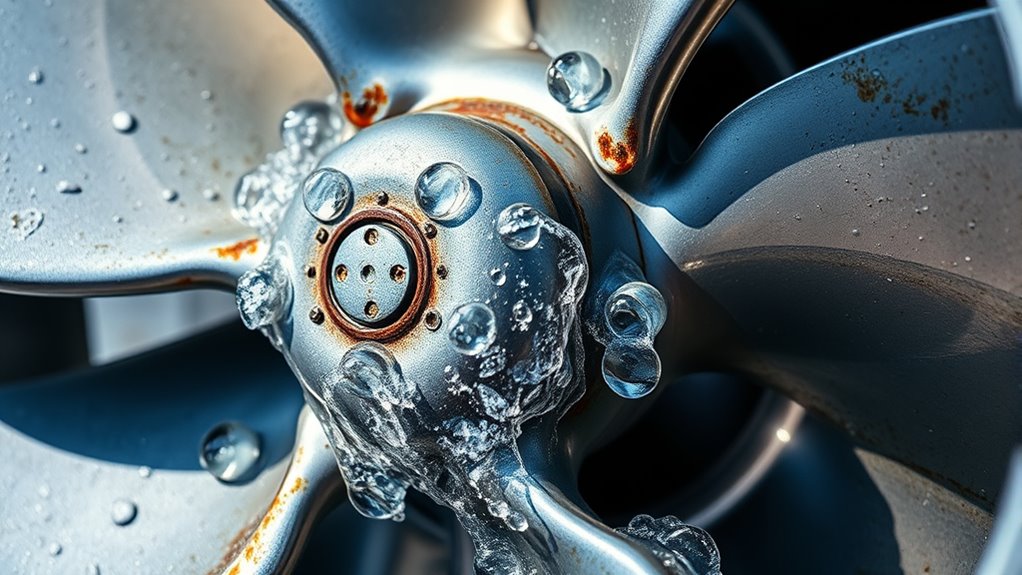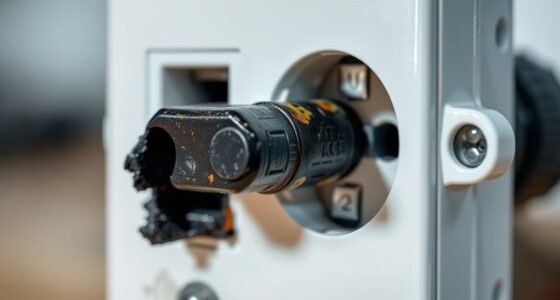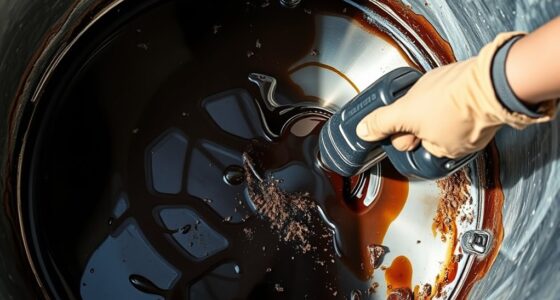If you notice a sudden drop in pump performance, strange noises like knocking, or increased vibrations, cavitation might be happening. It occurs when vapor bubbles form and collapse, damaging the impeller over time. To prevent this, check your inlet pressure, reduce flow rates, and make sure your system isn’t restricted. Proper maintenance and system adjustments can keep cavitation at bay. To understand more on how to identify and fix cavitation issues, keep exploring these solutions.
Key Takeaways
- Signs include noise, vibration, and sudden drops in pump performance and efficiency.
- Cavitation causes impeller blade pitting and erosion, leading to mechanical damage.
- Increasing inlet pressure or reducing flow rate helps prevent vapor bubble formation.
- Proper system design avoiding restrictions and abrupt bends minimizes pressure drops.
- Regular maintenance and monitoring detect early signs, reducing cavitation-related damage.

Have you ever wondered what causes a pump to suddenly lose efficiency or even get damaged? One of the main culprits is cavitation, a phenomenon that occurs when vapor bubbles form in the liquid being pumped due to pressure drops. These bubbles can collapse violently when they move to higher-pressure zones, causing serious issues inside the pump. If you notice a sudden drop in performance or unusual noises, cavitation might be the culprit. It can lead to impeller damage, which not only shortens the lifespan of your pump but also results in costly repairs. Recognizing the signs early is essential to prevent extensive damage and maintain peak operation.
When cavitation happens, the impeller faces repeated impacts from collapsing vapor bubbles. Over time, this can erode the impeller blades, creating pitting and weakening the entire impeller structure. This damage often manifests as increased vibration and noise, which can be mistaken for other problems. To combat this, noise reduction measures are necessary. By installing silencers or damping devices, you can minimize the noise caused by cavitation and reduce the stress on the impeller. Additionally, adjusting pump operating conditions—such as increasing inlet pressure or reducing flow rates—can help prevent vapor bubble formation altogether.
Another common cause of cavitation is operating the pump outside its recommended parameters. When the flow rate is too high or the suction pressure drops below the vapor pressure of the liquid, cavitation becomes more likely. Confirming that your pump operates within the manufacturer’s specified range is critical. Regular maintenance and monitoring can help catch issues before they escalate. For example, checking for signs of impeller damage or unusual vibrations can alert you to cavitation early. Installing sensors that measure pressure and flow can also provide real-time data, enabling swift corrective actions.
Furthermore, controlling the system’s temperature can help in preventing cavitation. Higher temperatures lower the liquid’s vapor pressure, making cavitation less likely. Properly designing the piping system to avoid sudden bends or restrictions can also improve flow consistency. If cavitation persists despite these measures, consider replacing the impeller with a more robust design or material that can withstand the impacts caused by vapor bubble collapse. Additionally, employing top-quality materials in impeller manufacturing can significantly improve resistance to cavitation damage. By combining these strategies—noise reduction, operating within specified parameters, system adjustments, and material improvements—you can considerably reduce cavitation risks, protect your impeller from damage, and ensure your pump operates smoothly and efficiently.
Frequently Asked Questions
How Does Cavitation Affect Pump Lifespan?
Cavitation shortens your pump’s lifespan by causing material degradation inside the impeller and other components. The repeated implosions from cavitation create shockwaves that wear down parts over time. Additionally, you’ll notice increased noise levels, indicating ongoing damage. If you ignore these signs, the pump’s efficiency drops, and repairs become more frequent and costly. Addressing cavitation early helps preserve your pump’s durability and prevents premature failure.
Can Cavitation Occur in All Pump Types?
The short answer is no, cavitation can’t occur in all pump types. While it’s most common in centrifugal pumps, it can also happen in other designs if operating conditions cause low pressure zones. You’ll notice impeller damage and increased noise levels when cavitation occurs. Don’t ignore these signs; they indicate that your pump is under stress and may need adjustments to prevent further damage.
What Are Early Indicators of Cavitation?
You’ll notice early signs of cavitation through increased noise levels and impeller damage. The noise often sounds like a rattling or banging, signaling bubbles collapsing inside the pump. Impeller damage might appear as cracks or pitting, caused by the violent collapse of vapor bubbles. Keep an eye on these indicators, as addressing them early can prevent more severe damage and maintain your pump’s efficiency.
How Does Fluid Temperature Influence Cavitation?
Imagine steam rising from hot water—fluid temperature greatly influences cavitation. As temperatures rise, fluid viscosity drops, making it easier for vapor bubbles to form and collapse, causing cavitation. Conversely, cooler fluids increase viscosity, reducing bubble formation. Proper temperature regulation helps maintain ideal fluid viscosity, preventing vapor pockets. You should monitor and control fluid temperature to minimize cavitation risk, ensuring your pump operates smoothly and efficiently.
Are There Environmental Impacts From Cavitation?
Yes, cavitation can cause environmental effects by damaging pump components and releasing debris into water, impacting water quality. When cavitation occurs, it may lead to leaks or failures that contaminate local ecosystems, especially in sensitive habitats. You should regularly monitor your pumps to prevent cavitation, protecting water quality and minimizing environmental impacts. Proper maintenance guarantees efficient operation, reducing the risk of environmental harm from cavitation-related damage.
Conclusion
By now, you see how essential it is to recognize pump cavitation’s signs and act swiftly. Ignoring these symptoms can lead to catastrophic failure, akin to a Titanic sinking. Always monitor your pump’s performance and maintain proper fluid levels. Remember, a proactive approach saves you time, money, and headaches—don’t wait for a medieval catastrophe to remind you. Stay vigilant, and keep your system running smoothly, for even the most advanced machinery needs attentive care.









